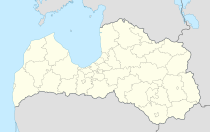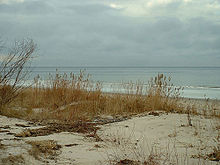Jurmala
| Jūrmala ( German : Riga Beach) | ||
|---|---|---|
 |
|
|
| Basic data | ||
| State : |
|
|
| Landscape: | Livonia ( Latvian : Vidzeme ) | |
| Administrative district : | Republic city of Jūrmala | |
| Coordinates : | 56 ° 58 ' N , 23 ° 46' E | |
| Residents : | 57,653 (Jul 1, 2018) | |
| Area : | 100 km² | |
| Population density : | 577 inhabitants per km² | |
| Height : | 3 m | |
| City law: | since 1959 | |
| Website: | www.jurmala.lv | |
| Post Code: | 2008-2017 | |
| ISO code: | ||
Jurmala ( German Riga beach ) is a Latvian Baltic Sea - resort on the Gulf of Riga with 57,653 inhabitants (as of 1 July 2018).
geography
The Lielupe flows into the sea in Jūrmala, and the Latvian capital Riga is 10 km southeast .
Jūrmala stretches about 40 km northwest of Riga along the coastline and is made up of 15 suburbs from west to east:
- Ķemeri, Jaunķemeri, Sloka, Kauguri, Vaivari, Asari, Melluži, Pumpuri, Jaundubulti, Dubulti, Majori ( Majorenhof ), Dzintari, Bulduri, Lielupe and Priedaine
The district of Bulduri was previously called the Bilderlingshof and before 1914 was the preferred seat of the German-Baltic intelligentsia, the money and blood nobility. A part between Dzintari and Bulduri was called Edinburgh for a while, in honor of the marriage between Maria Alexandrovna Romanova and the British Prince Alfred in 1874.
Jūrmala has recreational facilities, a promenade and restaurants . The place has a long white beach that stretches 10 km to the east towards Riga, while to the west, uninterrupted by anything, you can find more than 20 km in one piece.
Jūrmala is a health resort that can only be entered by guests from April 1st to September 30th after paying a road toll , a kind of tourist tax ; it is considered a preferred residential area. Worth seeing are villas in timber construction from the time of the turn of the century to the 20th century, in the Art Nouveau style were built. There are sulphurous medicinal springs in the schweemeri district .
history
In 1783 the area around Sloka (Schlock) was separated from the Duchy of Courland and taken over by the Russian Empire. Sloka received city rights in 1878. A paper mill was established in 1896. After the construction of the Torņakalns – Tukums railway line , the beach became a popular recreational area due to its proximity to Riga. Various beach resorts were combined in 1920 to form the city of "Rīgas Jūrmalas" (Riga Beach). In 1959 the independent city of Jūrmala was created by incorporating Sloka and Ķemeri.
The music competition "Jaunais vilnis" ( New Wave , Russian: Новая волна Nowaja Wolna ) took place in Jūrmala until 2014 . Musicians from the successor states of the Soviet Union take part in this competition . After three Russian artists who had supported the Russian annexation of Crimea were banned from entering the country , the Russian organizers canceled the long-running music competition and other festivals in Jūrmala and moved it to Sochi and Svetlogorsk .
In 2017/2018 the controversial new building of the Russian Orthodox Church of the Kazan Mother of God was built .
Facilities
Jūrmala is home to the famous Dzintaru koncertzāle concert hall and the Rainis and Aspazija Summer House literary museum .
Town twinning
Jūrmala names the following cities as twin cities:
-
 Admiralteisky rajon , Saint Petersburg , Russia
Admiralteisky rajon , Saint Petersburg , Russia -
 Alushta , Crimea, Ukraine
Alushta , Crimea, Ukraine -
 Anadia , Portugal
Anadia , Portugal -
 Anaklia , Georgia
Anaklia , Georgia -
 Ashdod , Israel
Ashdod , Israel -
 Cabourg , France
Cabourg , France -
 Khanty-Mansiysk , Russia
Khanty-Mansiysk , Russia -
 Eskilstuna , Sweden
Eskilstuna , Sweden -
 Gävle , Sweden
Gävle , Sweden -
 Jakobstad / Pietarsaari, Finland
Jakobstad / Pietarsaari, Finland -
 Jilin , China
Jilin , China -
 Kazan , Russia
Kazan , Russia -
 Moscow Oblast , Russia
Moscow Oblast , Russia -
 Palanga , Lithuania
Palanga , Lithuania -
 Parnu , Estonia
Parnu , Estonia -
 Samarqand , Uzbekistan
Samarqand , Uzbekistan -
 Shenyang , China
Shenyang , China -
 Terracina , Italy
Terracina , Italy -
 Türkmenbaşy , Turkmenistan
Türkmenbaşy , Turkmenistan -
 Zqaltubo , Georgia
Zqaltubo , Georgia
sons and daughters of the town
- (in the order of the year of birth)
- Reinhard Wittram (1902–1973), German historian
- Bruno von Freytag-Löringhoff (1912–1996), German philosopher and mathematician
- Alexander Jurjewitsch Kaleri (* 1956), Russian cosmonaut with missions on the Mir and the International Space Station ISS
- Artis Pabriks (* 1966), political scientist and politician, founding member of Tautas Partija, Latvian Foreign Minister from 2004 to 2007
- Edgars Rinkēvičs (* 1973), politician
- Daniels Pavļuts (* 1976), politician
- Arvīds Reķis (* 1979), ice hockey player
- Vestards Šimkus (* 1984), pianist
- Imants Blūzmanis (* 1987), pianist
- Roberts Bukarts (* 1990), ice hockey player
- Rihards Bukarts (* 1995), ice hockey player
literature
-
Olga Kurilo : Cranz - Sopot - Rigas Beach. Baltic seaside resorts in the 19th and 20th centuries. be.bra Wissenschaftsverlag, Berlin 2011, ISBN 978-3-937233-81-9 .
- Christoph Schutte: Review: Seaside resorts on the Baltic Sea in the 19th and 20th centuries . In: Sehepunkte 12 (2012), No. 1 from January 15, 2012.
- Astrīda Iltnere (ed.): Latvijas Pagasti, Enciklopēdija . Preses Nams, Riga 2002, ISBN 9984-00-436-8 .
Web links
- jurmala.lv Official website of the city (lat./engl./russ.)
- Pictures from Jurmala
Individual evidence
- ↑ Guide through Latvia , W. F. Häcker printing press, Riga 1929, p. 49 ff.
- ↑ Latvijas iedzīvotāju skaits pašvaldībās (Latvian; German population of the self-governing districts of Latvia ), as of July 1, 2018, p. 1, accessed on January 5, 2019.
- ↑ Riga newspaper on Sunday No. 153 of July 20, 1930; Retrieved on July 16, 2019 at periodika.lv .
- ↑ Krutoy also confirms that the "New Wave" will take place in Sochi. (Latvian), delfi.lv on February 26, 2015, accessed on July 16, 2019.
- ↑ Sadraudzības pilsētas (Latvian) on jurmala.lv, accessed on July 16, 2019



